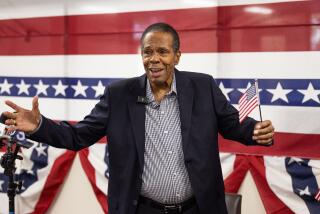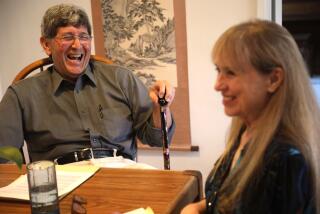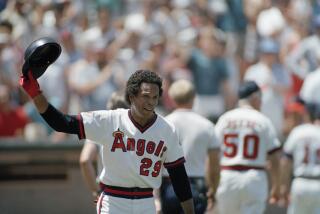A FATHER’S PRAYER: : ‘Give Her More Time’ : Rod Carew’s Daughter Michelle, in a Battle for Her Life, Waits for a Bone-Marrow Transplant
Rod Carew curls up on a family room sofa with the young woman they call “Miracle Child,” 18-year-old Michelle Carew, a leukemia victim and the youngest of Rod and Marilynn Carew’s three daughters. Michelle, clutching the peach-colored blanket her grandmother crocheted, nestles into her father’s arms, her back to his chest, their bodies forming a capital “S” and lower-case “s.” Rod’s hands, strong hands that gripped a baseball bat so masterfully during a 19-year major league career, pull Michelle close, evoking two powerful images--a father trying to protect his daughter; a father refusing to let his little girl go.
“Parents aren’t supposed to bury their children,” says Carew, the 50-year-old Angel batting instructor. “In November I said, ‘I can’t do this. How am I going to bury my child?’ If something happens to her, I don’t know how I would handle it. I keep telling My Friend Upstairs, ‘She’s a great kid, give her more time.’ ”
Marilynn Carew, a tirelessly devoted mother who spends most nights at Michelle’s side, sleeping on a fold-out chair in Room 306 of the Oncology Intensive Care Unit at Children’s Hospital of Orange County, cherishes each moment with her daughter. “Not a day goes by without thinking, ‘What should I say? What should I do?’ because you don’t know how much time you have left,” she says, dabbing at tears. “But I can’t picture life without her, so I refuse to believe that can happen.”
More than 61,000 calls to the National Marrow Donor Program have been generated by publicity from Michelle Carew, and the donor registry increased to 2 million in February--up from 1.5 million the previous year--thanks in large part to the Carews’ efforts to raise awareness.
But a potential donor who could provide life-giving bone marrow to Michelle has not been found. Her genetic background--she is the daughter of a black man with West Indian and Panamanian roots and a white mother with Russian-Jewish roots--makes it extremely difficult to find a match; Carew has likened the search to “finding a needle in a haystack.” In a bitter irony, Carew’s other two daughters, Charryse, 22, and Stephanie, 20, are a perfect match for each other, not Michelle.
Is there still time for a transplant? “Absolutely,” says Dr. Mitchell S. Cairo, director of bone-marrow transplantation and hemotology/oncology research at CHOC. “But we need to make a decision in the next few weeks.”
Although Michelle has been in remission for more than three months, doctors are in a holding pattern as they wait for a fungal infection in her sinuses to clear. If no donor is found or if the infection lingers, Cairo said he will probably treat Michelle with more chemotherapy and immune therapy, in which proteins are used to stimulate the immune system and kill leukemia cells.
If the infection clears and her white blood cell count rises, another option is an Autologous transplant, in which Michelle’s own marrow is harvested, treated with antibodies to kill leukemia, frozen and stored, and then returned to her body. Cairo said the success rate for the procedure is 30% to 60%, or about the same as a transplant with an unrelated donor’s marrow, though the risk of relapse is higher.
Michelle’s chances of survival dwindle each day a donor is not found, but the Carews are buoyed by the fact that, since Feb. 9, Michelle has felt well enough to come home for about four hours a day after spending five months in a sterilized hospital room. And that she has improved after enduring some 14 operations, one that saved her vision in September.
And that she survived two bouts with a killer known as septic shock, sidestepping death both times, and defied doctors who at one point gave her 48 hours to live. And that she emerged in December from a five-week period in which she was critically ill and needed round-the-clock care for serious complications such as respiratory failure, heart failure, liver and kidney failure, and extreme fever, with nothing more than a slight hearing loss.
Most of all, there is a prevailing belief that in Michelle Carew, an outgoing, unselfish, brave young woman, the deadly disease known as acute nonlymphocytic leukemia (ANLL) may have met its match.
“I’ve gone through so much stuff, if I didn’t beat this I’d be [ticked],” Michelle Carew says. “So I am going to beat it.”
*
Michelle Carew was writing a paper for a Cypress College freshman English class Sept. 10 when Marilynn found her slumped over her computer. Michelle complained of blurred vision, back pains and a headache. Rod and Marilynn thought her allergies were acting up; they gave her Tylenol and put her to bed.
The next day a family physician ran some blood tests. An infectious disease specialist was called. The Carews sensed something serious when Charryse noticed a slip of paper on the doctor’s desk. “Suspect leukemia,” it read. Blood tests were sent to more labs, and the diagnosis was confirmed: ANLL, one of the most aggressive strains of leukemia.
“How do you tell a 17-year-old kid she has leukemia?” Rod Carew asks. “The doctor said, ‘Your blood is a little dirty, we have to clean it up, you have leukemia.’ Michelle said, ‘Do I have a chance?’ The doctor said, ‘Yeah, 75-80%.’ She said, ‘OK, that’s all I need.’ There were no tears. She was the only one who wasn’t crying. The rest of us . . . went bananas.”
The initial treatment consisted of blood transfusions, followed by heavy chemotherapy, which destroys defective bone marrow but also wipes out the immune system, leaving the patient susceptible to infections. Michelle’s first major complication arose in late September, when a tumor behind her optic nerve rendered her almost blind. Rod was in Seattle for the Angels’ American League West Division-deciding series against the Mariners when the call came from his wife. “I’ve never called Rod in 25 years to come home,” Marilynn, 48, says. “I didn’t call for me or for her. I called for him, because I knew Michelle might never see his face again.”
Rod was on the next plane home--probably the first time he was able to suppress his tremendous fear of flying--and doctors saved Michelle’s sight after a lengthy operation, one of the few bright spots since her condition was diagnosed. “But from then on, it was one thing after another,” Rod says, “from staph infections, to inner-sinus infections, to fungal infections. . . .”
To septic shock, in which toxic waste from bacteria killed by antibiotics essentially attacks the body, forcing blood pressure to drop, body temperature to soar and heart rate to swing wildly. Michelle was on the final day of her fourth chemotherapy cycle on Nov. 14 when it hit for the second time.
“We were staring at her heart monitor and it went from 22 to 18 to 9 and then it was beeping,” Stephanie Carew said. “She sat up in bed and couldn’t breathe because her heart stopped. She flat-lined for about a minute. We were screaming, ‘Don’t leave us! Don’t leave us!’ ”
Rod and Marilynn had left the hospital for a brief period but rushed back after the call on their car phone. When Rod entered the room there was a crash cart at Michelle’s side and a dozen doctors and nurses working furiously. After vomiting when a nurse tried to snake a tube down her throat, Michelle saw Rod. “Daddy, I’m fighting,” she said weakly. “I’m fighting, Daddy.”
Recalls Rod: “That look on her face. . . . It’s the only thing I can say that in my 50 years on this earth I will never forget. It was this scared, but reassuring, look, like she was saying, ‘I’m going to be OK.’ ”
But she wasn’t. Michelle is convinced she actually died and came back to life that night. “I saw a guy in the corner of my room,” she says. “I saw a warm, bright light and a darker shade.” Tears stream down her face. Rod hugs her. Within a second, Michelle is smiling again, through the pain. “Then I heard my mom yelling at me, but she was in the car on the way to the hospital,” Michelle continued. “She was screaming, ‘Don’t you go anywhere! Wait till I get there.’ ” That’s exactly what Marilynn was saying on the way back to the hospital.
Michelle’s condition was touch and go for about 12 hours. By 10 p.m. she had stabilized, but doctors told the Carews, “There’s nothing more we can do.” Said Charryse: “We found out later they didn’t expect Michelle to live. The scariest thing is when doctors say she’s the only one to survive this severe a fungal infection. Two kids we know who had the same infections died. The doctors have nothing to compare this to, because no one has made it past this point. Michelle is the medical research.”
Michelle was in critical condition for the next five weeks, her senses dulled by astronomical doses of synthetic morphine. At one point doctors called the Food and Drug Administration for permission to increase her anti-fungal medication. “They wheeled and dealed 24 hours a day,” Marilynn said. “The staff kept her alive for two months. She’s a walking miracle.”
“Nah,” says Michelle, “just strong-willed. How could I let go? I wouldn’t be able to spend all of Daddy’s money.”
Through the suffering, Michelle has remained remarkably upbeat. “She has been to hell and back and doesn’t complain about a thing,” Rod says. She even finds the strength to laugh.
Asked what she liked most about coming home, Michelle, whose hair is starting to grow back after chemotherapy, said, “I like sticking my head out the window and feeling the wind through my hair, whatever’s left of it.” She was having trouble getting up from an ottoman, so she rocked back and forth, building momentum to rise. “Look Charryse, I feel like Grandma,” she joked.
“I like making people smile, and I’ll continue to do that,” says Michelle, who hopes to be a nurse. “I don’t think there’s a day that goes by when I don’t smile. Even when I cry I smile.”
About her only request has been that her father, something of a recluse during his playing days, try to help all kids who need bone marrow. “I didn’t think it should just be me, me, me,” Michelle says. “There’s all these other kids on the floor, so many in other hospitals who need this stuff, and I have a father who can do it. He did, and he did a pretty darn good job.”
*
Rod Carew was 12 when he got four hits off his father, Eric, in a fast-pitch softball game. “That night he whipped the daylights out of me,” Rod says. “I was so accustomed to the blows they didn’t even faze me.” Carew said his father “didn’t care about me; he wished I wasn’t born.”
Carew remains close to his mother, Olga, who lives in New York. As for his father, “I don’t know or care where he lives,” Rod says. “I haven’t talked to him since 1984.”
The day after Carew graduated from high school in 1964, he signed with the Minnesota Twins, and after three minor league seasons he launched a wildly successful big league career in which he won seven American League batting titles, most-valuable-player (1977) and rookie-of-the-year (1967) honors, and was named to 18 all-star teams. He had a .328 career batting average, 3,053 hits and was enshrined in baseball’s Hall of Fame in 1991.
But fans knew little about Carew because he often avoided reporters and was hardly embraced by the media. He hated talking about himself--it was part of the emotional barriers he put up because he was an abused child--but instead of ignoring the media he sometimes lashed out at reporters, creating stormy clubhouse relationships throughout the league. In fact, when a young Twin or Angel player would show disdain for the media, reporters would call him “another Rod Carew.”
But when Rod saw how few African Americans were registered in the bone marrow program; when the plea came from Michelle last November “to be my voice,” he did something that seemed so unnatural to him--he called a reporter. And then another. And another.
Newspapers began running stories on the Carews’ plight. Rod appeared on national television programs and taped public service announcements seeking donors for Michelle and others. He began stopping strangers on the street, handing them business cards with the phone number (1-800-MARROW2) of the National Marrow Donor Program in Minneapolis.
He even wrote to Abigail Van Buren, who printed Carew’s plea in her syndicated column: “Time is running out for my daughter. The percentages are not in her favor. . . . Our prayer is that the awareness of our daughter’s need, and the need of so many others, will motivate people to action.”
The response was overwhelming. Letters poured in from all over the world. People sent good-luck charms, such as four-leaf clovers and small angels. Michelle received enough stuffed animals to open a carnival booth. Upon hearing of Michelle’s wish to see snow falling, a New Jersey man sent a video of a snowstorm. The Rev. Jesse Jackson visited. Novelist Tom Clancy called. Angel players came by the hospital. One inmate who was serving his 20th year in prison sent a letter, offering to be tested.
“It has been unreal,” Carew said.
When Michelle became ill, neighbors helped keep the Carews’ refrigerator stocked, house cleaned and their pets--they have seven dogs, 10 cats and two snakes--fed. But as the media picked up on the story--there were even pleas on the Internet--both friends and strangers began organizing bone marrow drives, and the National Marrow Donor Program, whose registry increased gradually since its 1987 inception, experienced a dramatic jump in members.
“I’m sure lives will be saved because of them,” said Bonnie Martin, a spokesperson for the marrow program.
Angel infielder Rex Hudler, a frequent CHOC visitor, never knew about the bone marrow program. “But Rod opened my eyes,” he said. “He has increased awareness around the world. He has humbly put himself in a position where he’s needed, and because of him, something positive will come of this. He’s a changed man.”
Once aloof and unapproachable, Carew is now accessible and emotional. He has opened up to friends and cried in front of strangers. Carew, who tutors Angel batters during the week in Tempe, Ariz., but goes home to visit Michelle on weekends, has granted interviews almost daily during spring training. The more he talks, the more media outlets he reaches, the better the chance donors will be found for Michelle and others.
“It’s scary that such a bad thing had to happen to wake people up,” Michelle says. “What if I didn’t get leukemia? Would there be all these blood drives? I don’t think so, and that’s kind of scary. But because of me and my father, hopefully other people will have a better chance.”
More to Read
Sign up for Essential California
The most important California stories and recommendations in your inbox every morning.
You may occasionally receive promotional content from the Los Angeles Times.











